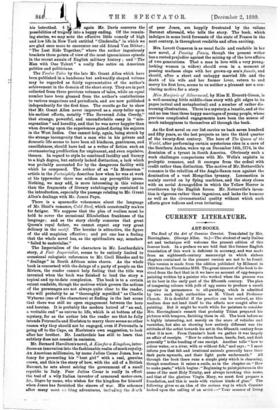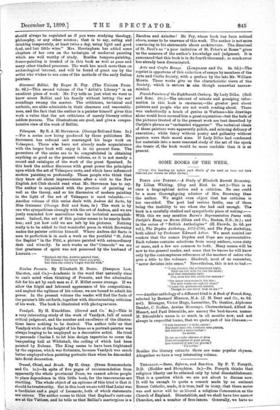CURRENT LITERATURE.
ART-BOOKS.
The Book of the Art of Cennino Cennini. Translated by Mrs. Herringham. (George Allen. 6s.)—The student of early Italian art and technique will welcome the present edition of this famous book. In a preface we are told that the former English translation of this work is deficient in accuracy, and was made from an eighteenth-century manuscript in which sixteen chapters contained in the present version are not to be found. This version is made from the edition published by Milanesi in 1859 from the Florentine MSS. The great interest of the book is de- rived from the fact that in it we have an account of egg-tempera painting written by a painter who worked when the process was at its best in the early part of the fifteenth century. The plan of tempering colours with yolk of egg seems to produce a result superior in permanence to oil-painting, which is admitted by two such high authorities as M. Vibert and Professor Church. It is doubtful if the practice can be revived, as this medium does not lend itself to the effects now sought after in painting. But it might be worth while for painters to consider Mrs. Herringham's remark that probably Titian prepared his pictures with tempera, finishing them in oil. The book before us is highly interesting, not merely on the score of vehicles and varnishes, but also as showing how entirely different was the attitude of the artist towards his art in the fifteenth century from what it is now. From Cennino's book we gather it was largely an affair of receipts. "How to colour faces, hands, feet, and flesh generally" is the heading of one receipt. Another tells "how to colour water, or a river, with or without fish," and says : " I must inform you that fish and irrational animals generally have their dark parts upwards, and their light parts underneath." All through the book there rune a simple piety which is charming, though sometimes it raises a smile, as in the chapter on "How to make paste," which begins : "Beginning to paint pictures in the name of the most Holy Trinity, and always invoking this name, and that of the glorious Virgin Mary, we must first prepare a foundation, and this is made with various kinds of glue." The following gives us an idea of the serious way in which Cennino looked upon the calling of an artist :—" Your manner of living should always be regulated as if you were studying theology, philosophy, or any other science ; that is to say, eating and drinking temperately, at least twice a day, using light and good fcod, and but little wine." Mrs. Herringham has added some chapters of her own on the technique of mediteval painting which are well worthy of study. Besides tempera-painting, fresco-painting is treated of in this book as well as gesso and many other kindred processes. The work has much more than an archwological interest, and will be found of great use by the artist who wishes to use some of the methods of the early Italian painters.























































 Previous page
Previous page